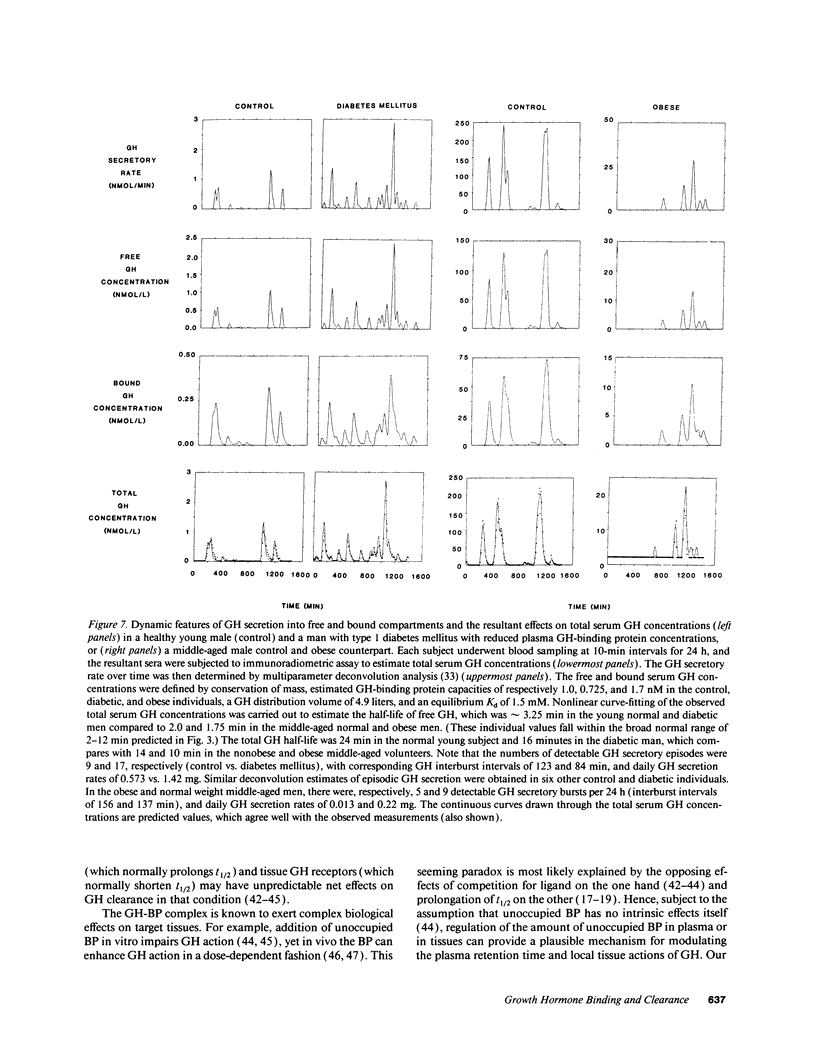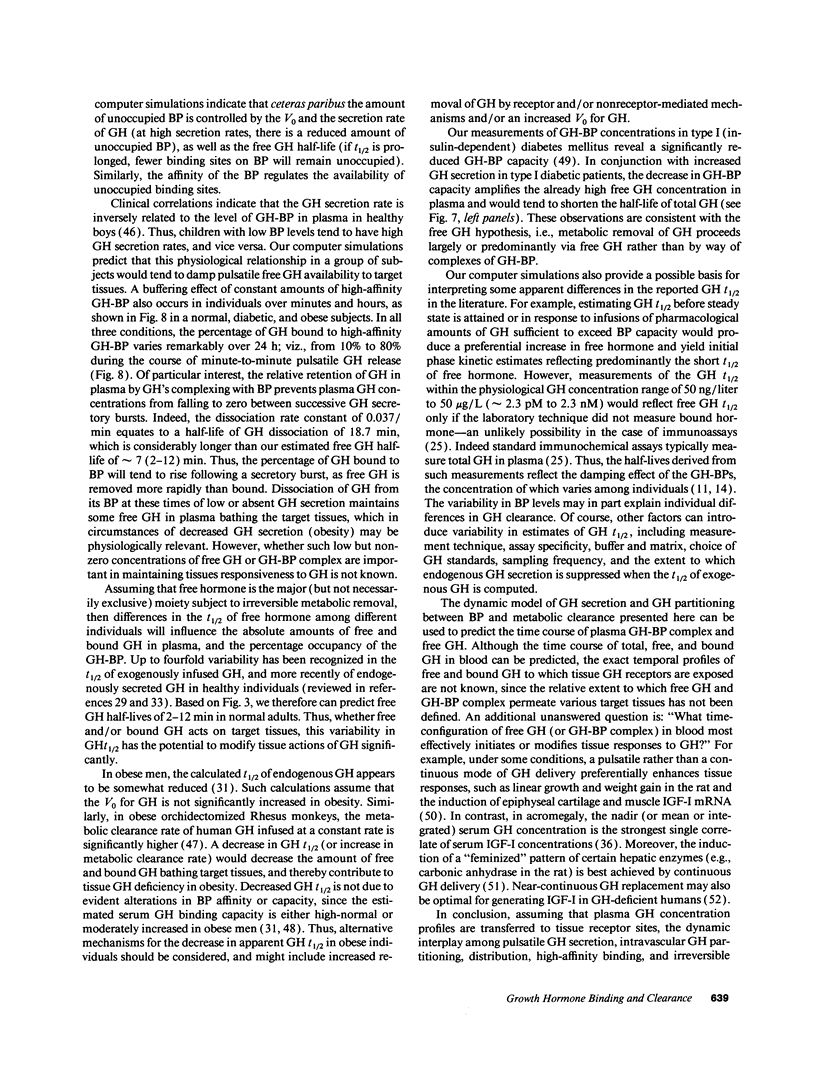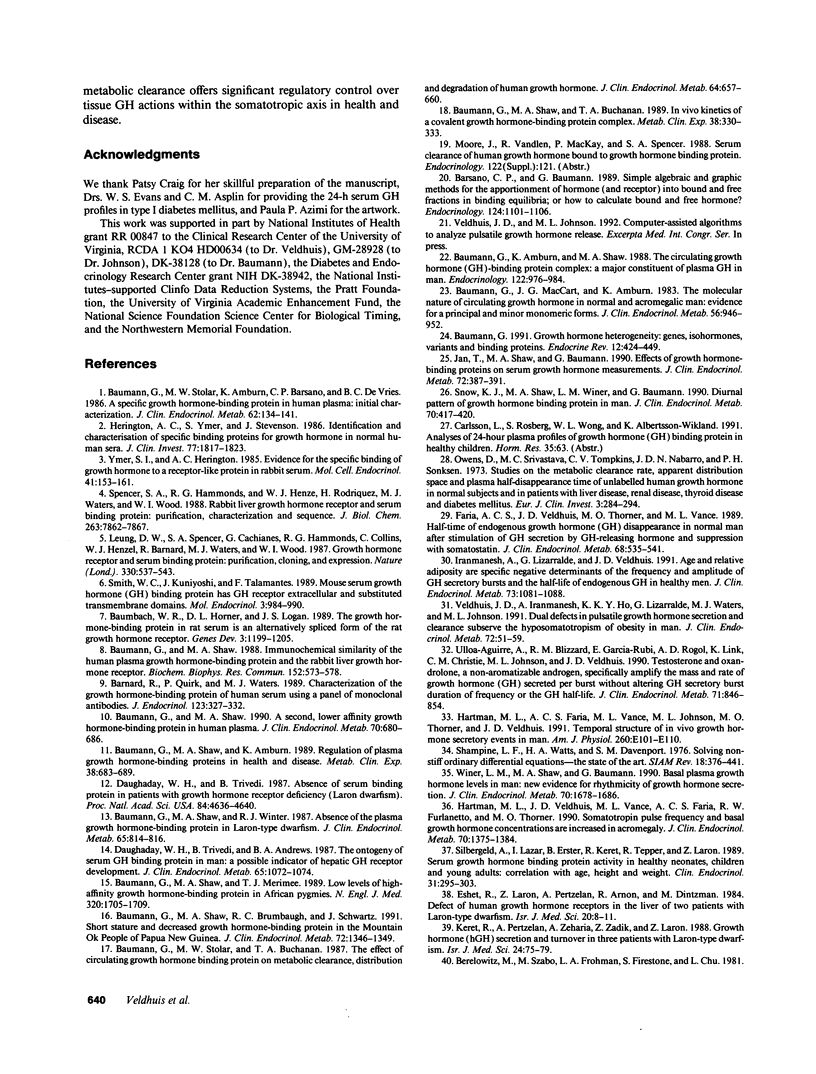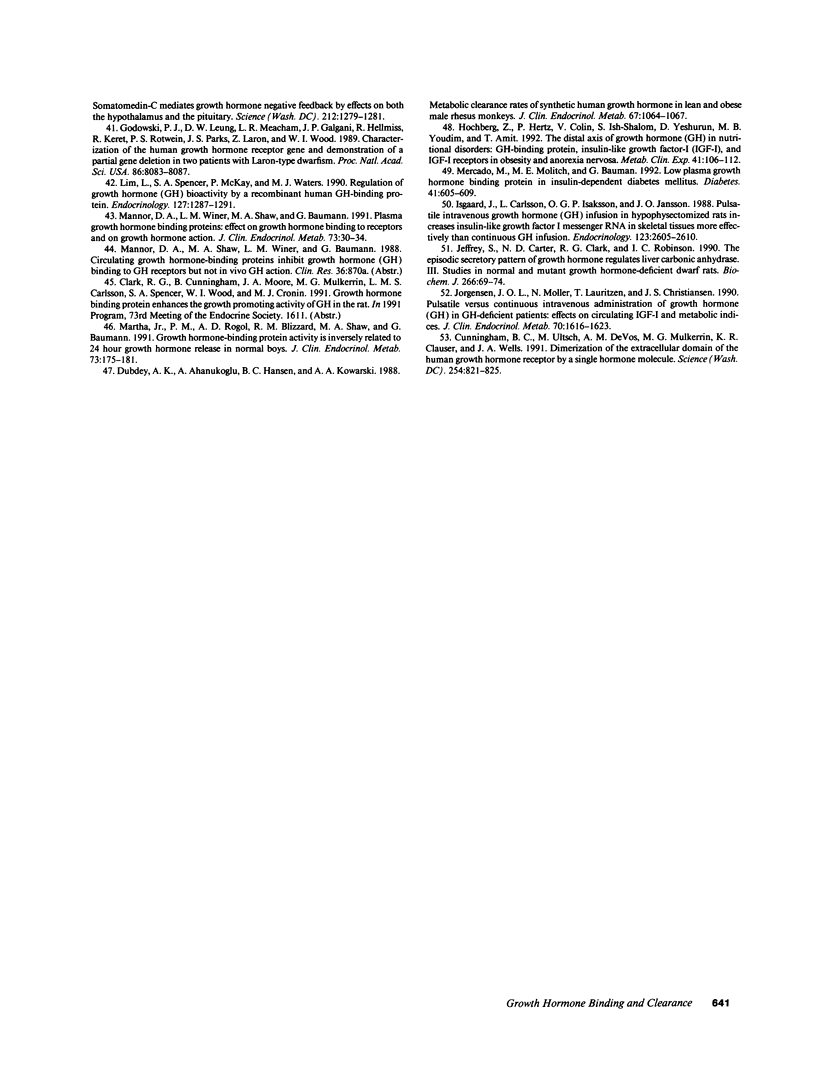Abstract
The discovery of a specific high-affinity growth hormone (GH) binding protein (GH-BP) in plasma adds complexity to the dynamics of GH secretion and clearance. Intuitive predictions are that such a protein would damp sharp oscillations in GH concentrations otherwise caused by bursts of GH secretion into the blood volume, prolong the apparent half-life of circulating GH, and contribute a reservoir function. To test these implicit considerations, we formulated an explicit mathematical model of pulsatile GH secretion and clearance in the presence of absence of a specific high-affinity GH-BP. Simulation experiments revealed that the pulsatile mode of physiological GH secretion creates a highly dynamic (nonequilibrium) system, in which the half-life of free GH, its instantaneous secretion rate, and the GH-BP affinity and capacity all contribute to defining momentary levels of free, bound, and total GH, the percentage of GH bound to protein, and the percentage occupancy of GH-BP [corrected]. In contrast, the amount of free GH at equilibrium is specified only by the GH distribution volume and secretion rate and the half-life of free hormone. We conclude that the in vivo dynamics of GH secretion, trapping, and clearance from the circulation offer a variety of regulatory loci at which the time structure of free, bound, and total GH delivery to target tissues can be controlled physiologically.
Full text
PDF












Selected References
These references are in PubMed. This may not be the complete list of references from this article.
- Barnard R., Quirk P., Waters M. J. Characterization of the growth hormone-binding protein of human serum using a panel of monoclonal antibodies. J Endocrinol. 1989 Nov;123(2):327–332. doi: 10.1677/joe.0.1230327. [DOI] [PubMed] [Google Scholar]
- Barsano C. P., Baumann G. Simple algebraic and graphic methods for the apportionment of hormone (and receptor) into bound and free fractions in binding equilibria; or how to calculate bound and free hormone? Endocrinology. 1989 Mar;124(3):1101–1106. doi: 10.1210/endo-124-3-1101. [DOI] [PubMed] [Google Scholar]
- Baumann G., Amburn K. D., Buchanan T. A. The effect of circulating growth hormone-binding protein on metabolic clearance, distribution, and degradation of human growth hormone. J Clin Endocrinol Metab. 1987 Apr;64(4):657–660. doi: 10.1210/jcem-64-4-657. [DOI] [PubMed] [Google Scholar]
- Baumann G., Amburn K., Shaw M. A. The circulating growth hormone (GH)-binding protein complex: a major constituent of plasma GH in man. Endocrinology. 1988 Mar;122(3):976–984. doi: 10.1210/endo-122-3-976. [DOI] [PubMed] [Google Scholar]
- Baumann G. Growth hormone heterogeneity: genes, isohormones, variants, and binding proteins. Endocr Rev. 1991 Nov;12(4):424–449. doi: 10.1210/edrv-12-4-424. [DOI] [PubMed] [Google Scholar]
- Baumann G., MacCart J. G., Amburn K. The molecular nature of circulating growth hormone in normal and acromegalic man: evidence for a principal and minor monomeric forms. J Clin Endocrinol Metab. 1983 May;56(5):946–952. doi: 10.1210/jcem-56-5-946. [DOI] [PubMed] [Google Scholar]
- Baumann G., Shaw M. A. A second, lower affinity growth hormone-binding protein in human plasma. J Clin Endocrinol Metab. 1990 Mar;70(3):680–686. doi: 10.1210/jcem-70-3-680. [DOI] [PubMed] [Google Scholar]
- Baumann G., Shaw M. A., Amburn K. Regulation of plasma growth hormone-binding proteins in health and disease. Metabolism. 1989 Jul;38(7):683–689. doi: 10.1016/0026-0495(89)90108-x. [DOI] [PubMed] [Google Scholar]
- Baumann G., Shaw M. A., Brumbaugh R. C., Schwartz J. Short stature and decreased serum growth hormone-binding protein in the Mountain Ok people of Papua New Guinea. J Clin Endocrinol Metab. 1991 Jun;72(6):1346–1349. doi: 10.1210/jcem-72-6-1346. [DOI] [PubMed] [Google Scholar]
- Baumann G., Shaw M. A., Buchanan T. A. In vivo kinetics of a covalent growth hormone-binding protein complex. Metabolism. 1989 Apr;38(4):330–333. doi: 10.1016/0026-0495(89)90119-4. [DOI] [PubMed] [Google Scholar]
- Baumann G., Shaw M. A. Immunochemical similarity of the human plasma growth hormone-binding protein and the rabbit liver growth hormone receptor. Biochem Biophys Res Commun. 1988 Apr 29;152(2):573–578. doi: 10.1016/s0006-291x(88)80076-7. [DOI] [PubMed] [Google Scholar]
- Baumann G., Shaw M. A., Merimee T. J. Low levels of high-affinity growth hormone-binding protein in African pygmies. N Engl J Med. 1989 Jun 29;320(26):1705–1709. doi: 10.1056/NEJM198906293202601. [DOI] [PubMed] [Google Scholar]
- Baumann G., Shaw M. A., Winter R. J. Absence of the plasma growth hormone-binding protein in Laron-type dwarfism. J Clin Endocrinol Metab. 1987 Oct;65(4):814–816. doi: 10.1210/jcem-65-4-814. [DOI] [PubMed] [Google Scholar]
- Baumann G., Stolar M. W., Amburn K., Barsano C. P., DeVries B. C. A specific growth hormone-binding protein in human plasma: initial characterization. J Clin Endocrinol Metab. 1986 Jan;62(1):134–141. doi: 10.1210/jcem-62-1-134. [DOI] [PubMed] [Google Scholar]
- Baumbach W. R., Horner D. L., Logan J. S. The growth hormone-binding protein in rat serum is an alternatively spliced form of the rat growth hormone receptor. Genes Dev. 1989 Aug;3(8):1199–1205. doi: 10.1101/gad.3.8.1199. [DOI] [PubMed] [Google Scholar]
- Cunningham B. C., Ultsch M., De Vos A. M., Mulkerrin M. G., Clauser K. R., Wells J. A. Dimerization of the extracellular domain of the human growth hormone receptor by a single hormone molecule. Science. 1991 Nov 8;254(5033):821–825. doi: 10.1126/science.1948064. [DOI] [PubMed] [Google Scholar]
- Daughaday W. H., Trivedi B. Absence of serum growth hormone binding protein in patients with growth hormone receptor deficiency (Laron dwarfism). Proc Natl Acad Sci U S A. 1987 Jul;84(13):4636–4640. doi: 10.1073/pnas.84.13.4636. [DOI] [PMC free article] [PubMed] [Google Scholar]
- Daughaday W. H., Trivedi B., Andrews B. A. The ontogeny of serum GH binding protein in man: a possible indicator of hepatic GH receptor development. J Clin Endocrinol Metab. 1987 Nov;65(5):1072–1074. doi: 10.1210/jcem-65-5-1072. [DOI] [PubMed] [Google Scholar]
- Dubey A. K., Hanukoglu A., Hansen B. C., Kowarski A. A. Metabolic clearance rates of synthetic human growth hormone in lean and obese male rhesus monkeys. J Clin Endocrinol Metab. 1988 Nov;67(5):1064–1067. doi: 10.1210/jcem-67-5-1064. [DOI] [PubMed] [Google Scholar]
- Eshet R., Laron Z., Pertzelan A., Arnon R., Dintzman M. Defect of human growth hormone receptors in the liver of two patients with Laron-type dwarfism. Isr J Med Sci. 1984 Jan;20(1):8–11. [PubMed] [Google Scholar]
- Faria A. C., Veldhuis J. D., Thorner M. O., Vance M. L. Half-time of endogenous growth hormone (GH) disappearance in normal man after stimulation of GH secretion by GH-releasing hormone and suppression with somatostatin. J Clin Endocrinol Metab. 1989 Mar;68(3):535–541. doi: 10.1210/jcem-68-3-535. [DOI] [PubMed] [Google Scholar]
- Godowski P. J., Leung D. W., Meacham L. R., Galgani J. P., Hellmiss R., Keret R., Rotwein P. S., Parks J. S., Laron Z., Wood W. I. Characterization of the human growth hormone receptor gene and demonstration of a partial gene deletion in two patients with Laron-type dwarfism. Proc Natl Acad Sci U S A. 1989 Oct;86(20):8083–8087. doi: 10.1073/pnas.86.20.8083. [DOI] [PMC free article] [PubMed] [Google Scholar]
- Hartman M. L., Faria A. C., Vance M. L., Johnson M. L., Thorner M. O., Veldhuis J. D. Temporal structure of in vivo growth hormone secretory events in humans. Am J Physiol. 1991 Jan;260(1 Pt 1):E101–E110. doi: 10.1152/ajpendo.1991.260.1.E101. [DOI] [PubMed] [Google Scholar]
- Hartman M. L., Veldhuis J. D., Vance M. L., Faria A. C., Furlanetto R. W., Thorner M. O. Somatotropin pulse frequency and basal concentrations are increased in acromegaly and are reduced by successful therapy. J Clin Endocrinol Metab. 1990 May;70(5):1375–1384. doi: 10.1210/jcem-70-5-1375. [DOI] [PubMed] [Google Scholar]
- Herington A. C., Ymer S., Stevenson J. Identification and characterization of specific binding proteins for growth hormone in normal human sera. J Clin Invest. 1986 Jun;77(6):1817–1823. doi: 10.1172/JCI112507. [DOI] [PMC free article] [PubMed] [Google Scholar]
- Hochberg Z., Hertz P., Colin V., Ish-Shalom S., Yeshurun D., Youdim M. B., Amit T. The distal axis of growth hormone (GH) in nutritional disorders: GH-binding protein, insulin-like growth factor-I (IGF-I), and IGF-I receptors in obesity and anorexia nervosa. Metabolism. 1992 Jan;41(1):106–112. doi: 10.1016/0026-0495(92)90198-j. [DOI] [PubMed] [Google Scholar]
- Iranmanesh A., Lizarralde G., Veldhuis J. D. Age and relative adiposity are specific negative determinants of the frequency and amplitude of growth hormone (GH) secretory bursts and the half-life of endogenous GH in healthy men. J Clin Endocrinol Metab. 1991 Nov;73(5):1081–1088. doi: 10.1210/jcem-73-5-1081. [DOI] [PubMed] [Google Scholar]
- Isgaard J., Carlsson L., Isaksson O. G., Jansson J. O. Pulsatile intravenous growth hormone (GH) infusion to hypophysectomized rats increases insulin-like growth factor I messenger ribonucleic acid in skeletal tissues more effectively than continuous GH infusion. Endocrinology. 1988 Dec;123(6):2605–2610. doi: 10.1210/endo-123-6-2605. [DOI] [PubMed] [Google Scholar]
- Jan T., Shaw M. A., Baumann G. Effects of growth hormone-binding proteins on serum growth hormone measurements. J Clin Endocrinol Metab. 1991 Feb;72(2):387–391. doi: 10.1210/jcem-72-2-387. [DOI] [PubMed] [Google Scholar]
- Jeffery S., Carter N. D., Clark R. G., Robinson I. C. The episodic secretory pattern of growth hormone regulates liver carbonic anhydrase III. Studies in normal and mutant growth-hormone-deficient dwarf rats. Biochem J. 1990 Feb 15;266(1):69–74. doi: 10.1042/bj2660069. [DOI] [PMC free article] [PubMed] [Google Scholar]
- Jørgensen J. O., Møller N., Lauritzen T., Christiansen J. S. Pulsatile versus continuous intravenous administration of growth hormone (GH) in GH-deficient patients: effects on circulating insulin-like growth factor-I and metabolic indices. J Clin Endocrinol Metab. 1990 Jun;70(6):1616–1623. doi: 10.1210/jcem-70-6-1616. [DOI] [PubMed] [Google Scholar]
- Keret R., Pertzelan A., Zeharia A., Zadik Z., Laron Z. Growth hormone (hGH) secretion and turnover in three patients with Laron-type dwarfism. Isr J Med Sci. 1988 Feb;24(2):75–79. [PubMed] [Google Scholar]
- Leung D. W., Spencer S. A., Cachianes G., Hammonds R. G., Collins C., Henzel W. J., Barnard R., Waters M. J., Wood W. I. Growth hormone receptor and serum binding protein: purification, cloning and expression. Nature. 1987 Dec 10;330(6148):537–543. doi: 10.1038/330537a0. [DOI] [PubMed] [Google Scholar]
- Lim L., Spencer S. A., McKay P., Waters M. J. Regulation of growth hormone (GH) bioactivity by a recombinant human GH-binding protein. Endocrinology. 1990 Sep;127(3):1287–1291. doi: 10.1210/endo-127-3-1287. [DOI] [PubMed] [Google Scholar]
- Mannor D. A., Winer L. M., Shaw M. A., Baumann G. Plasma growth hormone (GH)-binding proteins: effect on GH binding to receptors and GH action. J Clin Endocrinol Metab. 1991 Jul;73(1):30–34. doi: 10.1210/jcem-73-1-30. [DOI] [PubMed] [Google Scholar]
- Martha P. M., Jr, Rogol A. D., Blizzard R. M., Shaw M. A., Baumann G. Growth hormone-binding protein activity is inversely related to 24-hour growth hormone release in normal boys. J Clin Endocrinol Metab. 1991 Jul;73(1):175–181. doi: 10.1210/jcem-73-1-175. [DOI] [PubMed] [Google Scholar]
- Mercado M., Molitch M. E., Baumann G. Low plasma growth hormone binding protein in IDDM. Diabetes. 1992 May;41(5):605–609. doi: 10.2337/diab.41.5.605. [DOI] [PubMed] [Google Scholar]
- Owens D., Srivastava M. C., Tompkins C. V., Nabarro J. D., Sönksen P. H. Studies on the metabolic clearance rate, apparent distribution space and plasma half-disappearance time of unlabelled human growth hormone in normal subjects and in patients with liver disease, renal disease, thyroid disease and diabetes mellitus. Eur J Clin Invest. 1973 Jul;3(4):284–294. doi: 10.1111/j.1365-2362.1973.tb00353.x. [DOI] [PubMed] [Google Scholar]
- Silbergeld A., Lazar L., Erster B., Keret R., Tepper R., Laron Z. Serum growth hormone binding protein activity in healthy neonates, children and young adults: correlation with age, height and weight. Clin Endocrinol (Oxf) 1989 Sep;31(3):295–303. doi: 10.1111/j.1365-2265.1989.tb01253.x. [DOI] [PubMed] [Google Scholar]
- Smith W. C., Kuniyoshi J., Talamantes F. Mouse serum growth hormone (GH) binding protein has GH receptor extracellular and substituted transmembrane domains. Mol Endocrinol. 1989 Jun;3(6):984–990. doi: 10.1210/mend-3-6-984. [DOI] [PubMed] [Google Scholar]
- Snow K. J., Shaw M. A., Winer L. M., Baumann G. Diurnal pattern of plasma growth hormone-binding protein in man. J Clin Endocrinol Metab. 1990 Feb;70(2):417–420. doi: 10.1210/jcem-70-2-417. [DOI] [PubMed] [Google Scholar]
- Spencer S. A., Hammonds R. G., Henzel W. J., Rodriguez H., Waters M. J., Wood W. I. Rabbit liver growth hormone receptor and serum binding protein. Purification, characterization, and sequence. J Biol Chem. 1988 Jun 5;263(16):7862–7867. [PubMed] [Google Scholar]
- Ulloa-Aguirre A., Blizzard R. M., Garcia-Rubi E., Rogol A. D., Link K., Christie C. M., Johnson M. L., Veldhuis J. D. Testosterone and oxandrolone, a nonaromatizable androgen, specifically amplify the mass and rate of growth hormone (GH) secreted per burst without altering GH secretory burst duration or frequency or the GH half-life. J Clin Endocrinol Metab. 1990 Oct;71(4):846–854. doi: 10.1210/jcem-71-4-846. [DOI] [PubMed] [Google Scholar]
- Veldhuis J. D., Iranmanesh A., Ho K. K., Waters M. J., Johnson M. L., Lizarralde G. Dual defects in pulsatile growth hormone secretion and clearance subserve the hyposomatotropism of obesity in man. J Clin Endocrinol Metab. 1991 Jan;72(1):51–59. doi: 10.1210/jcem-72-1-51. [DOI] [PubMed] [Google Scholar]
- Winer L. M., Shaw M. A., Baumann G. Basal plasma growth hormone levels in man: new evidence for rhythmicity of growth hormone secretion. J Clin Endocrinol Metab. 1990 Jun;70(6):1678–1686. doi: 10.1210/jcem-70-6-1678. [DOI] [PubMed] [Google Scholar]
- Ymer S. I., Herington A. C. Evidence for the specific binding of growth hormone to a receptor-like protein in rabbit serum. Mol Cell Endocrinol. 1985 Jul;41(2-3):153–161. doi: 10.1016/0303-7207(85)90018-8. [DOI] [PubMed] [Google Scholar]


